Pedram Johari
Enabling Site-Specific Cellular Network Simulation Through Ray-Tracing-Driven ns-3
Aug 06, 2025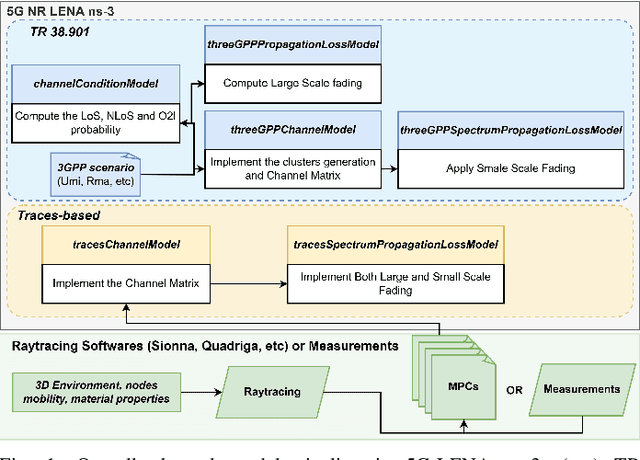
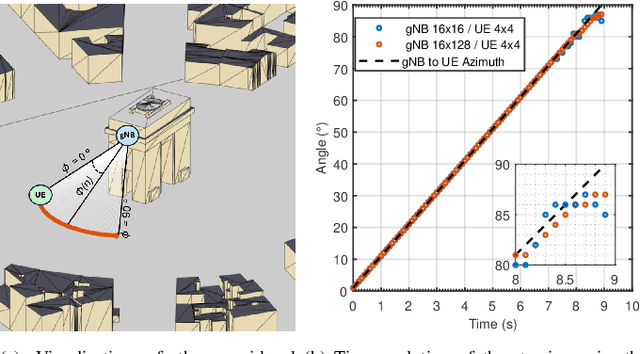
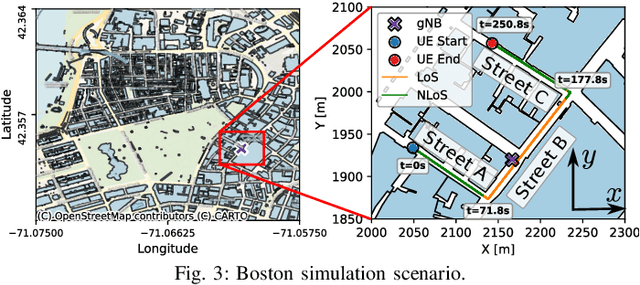
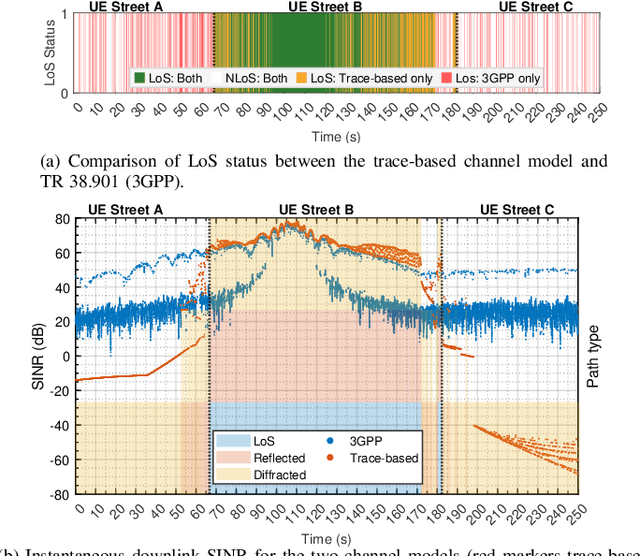
Abstract:Evaluating cellular systems, from 5G New Radio (NR) and 5G-Advanced to 6G, is challenging because the performance emerges from the tight coupling of propagation, beam management, scheduling, and higher-layer interactions. System-level simulation is therefore indispensable, yet the vast majority of studies rely on the statistical 3GPP channel models. These are well suited to capture average behavior across many statistical realizations, but cannot reproduce site-specific phenomena such as corner diffraction, street-canyon blockage, or deterministic line-of-sight conditions and angle-of-departure/arrival relationships that drive directional links. This paper extends 5G-LENA, an NR module for the system-level Network Simulator 3 (ns-3), with a trace-based channel model that processes the Multipath Components (MPCs) obtained from external ray-tracers (e.g., Sionna Ray Tracer (RT)) or measurement campaigns. Our module constructs frequency-domain channel matrices and feeds them to the existing Physical (PHY)/Medium Access Control (MAC) stack without any further modifications. The result is a geometry-based channel model that remains fully compatible with the standard 3GPP implementation in 5G-LENA, while delivering site-specific geometric fidelity. This new module provides a key building block toward Digital Twin (DT) capabilities by offering realistic site-specific channel modeling, unlocking studies that require site awareness, including beam management, blockage mitigation, and environment-aware sensing. We demonstrate its capabilities for precise beam-steering validation and end-to-end metric analysis. In both cases, the trace-driven engine exposes performance inflections that the statistical model does not exhibit, confirming its value for high-fidelity system-level cellular networks research and as a step toward DT applications.
AI-assisted Agile Propagation Modeling for Real-time Digital Twin Wireless Networks
Oct 29, 2024Abstract:Accurate channel modeling in real-time faces remarkable challenge due to the complexities of traditional methods such as ray tracing and field measurements. AI-based techniques have emerged to address these limitations, offering rapid, precise predictions of channel properties through ground truth data. This paper introduces an innovative approach to real-time, high-fidelity propagation modeling through advanced deep learning. Our model integrates 3D geographical data and rough propagation estimates to generate precise path gain predictions. By positioning the transmitter centrally, we simplify the model and enhance its computational efficiency, making it amenable to larger scenarios. Our approach achieves a normalized Root Mean Squared Error of less than 0.035 dB over a 37,210 square meter area, processing in just 46 ms on a GPU and 183 ms on a CPU. This performance significantly surpasses traditional high-fidelity ray tracing methods, which require approximately three orders of magnitude more time. Additionally, the model's adaptability to real-world data highlights its potential to revolutionize wireless network design and optimization, through enabling real-time creation of adaptive digital twins of real-world wireless scenarios in dynamic environments.
A Multi-Modal Non-Invasive Deep Learning Framework for Progressive Prediction of Seizures
Oct 26, 2024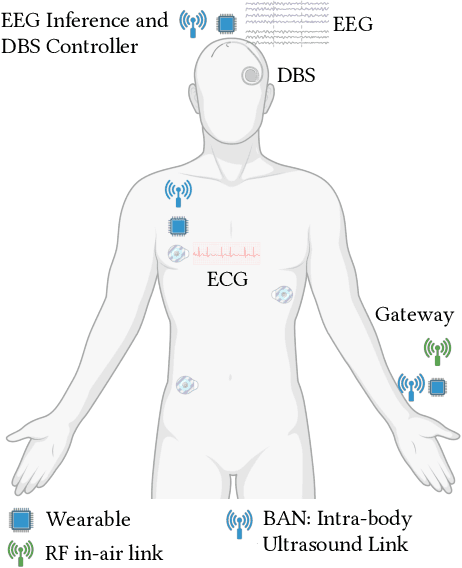


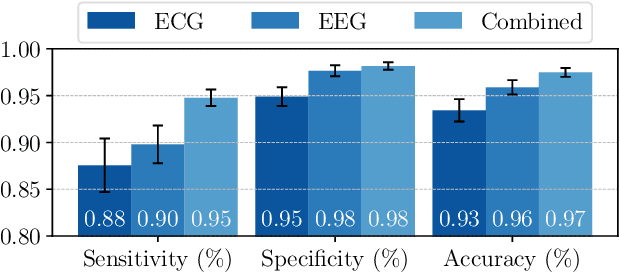
Abstract:This paper introduces an innovative framework designed for progressive (granular in time to onset) prediction of seizures through the utilization of a Deep Learning (DL) methodology based on non-invasive multi-modal sensor networks. Epilepsy, a debilitating neurological condition, affects an estimated 65 million individuals globally, with a substantial proportion facing drug-resistant epilepsy despite pharmacological interventions. To address this challenge, we advocate for predictive systems that provide timely alerts to individuals at risk, enabling them to take precautionary actions. Our framework employs advanced DL techniques and uses personalized data from a network of non-invasive electroencephalogram (EEG) and electrocardiogram (ECG) sensors, thereby enhancing prediction accuracy. The algorithms are optimized for real-time processing on edge devices, mitigating privacy concerns and minimizing data transmission overhead inherent in cloud-based solutions, ultimately preserving battery energy. Additionally, our system predicts the countdown time to seizures (with 15-minute intervals up to an hour prior to the onset), offering critical lead time for preventive actions. Our multi-modal model achieves 95% sensitivity, 98% specificity, and 97% accuracy, averaged among 29 patients.
Listen-While-Talking: Toward dApp-based Real-Time Spectrum Sharing in O-RAN
Jul 06, 2024Abstract:This demo paper presents a dApp-based real-time spectrum sharing scenario where a 5th generation (5G) base station implementing the NR stack adapts its transmission and reception strategies based on the incumbent priority users in the Citizen Broadband Radio Service (CBRS) band. The dApp is responsible for obtaining relevant measurements from the Next Generation Node Base (gNB), running the spectrum sensing inference, and configuring the gNB with a control action upon detecting the primary incumbent user transmissions. This approach is built on dApps, which extend the O-RAN framework to the real-time and user plane domains. Thus, it avoids the need of dedicated Spectrum Access Systems (SASs) in the CBRS band. The demonstration setup is based on the open-source 5G OpenAirInterface (OAI) framework, where we have implemented a dApp interfaced with a gNB and communicating with a Commercial Off-the-Shelf (COTS) User Equipment (UE) in an over-the-air wireless environment. When an incumbent user has active transmission, the dApp will detect and inform the primary user presence to the gNB. The dApps will also enforce a control policy that adapts the scheduling and transmission policy of the Radio Access Network (RAN). This demo provides valuable insights into the potential of using dApp-based spectrum sensing with O-RAN architecture in next generation cellular networks.
BostonTwin: the Boston Digital Twin for Ray-Tracing in 6G Networks
Mar 18, 2024



Abstract:Digital twins are now a staple of wireless networks design and evolution. Creating an accurate digital copy of a real system offers numerous opportunities to study and analyze its performance and issues. It also allows designing and testing new solutions in a risk-free environment, and applying them back to the real system after validation. A candidate technology that will heavily rely on digital twins for design and deployment is 6G, which promises robust and ubiquitous networks for eXtended Reality (XR) and immersive communications solutions. In this paper, we present BostonTwin, a dataset that merges a high-fidelity 3D model of the city of Boston, MA, with the existing geospatial data on cellular base stations deployments, in a ray-tracing-ready format. Thus, BostonTwin enables not only the instantaneous rendering and programmatic access to the building models, but it also allows for an accurate representation of the electromagnetic propagation environment in the real-world city of Boston. The level of detail and accuracy of this characterization is crucial to designing 6G networks that can support the strict requirements of sensitive and high-bandwidth applications, such as XR and immersive communication.
SeizNet: An AI-enabled Implantable Sensor Network System for Seizure Prediction
Jan 12, 2024



Abstract:In this paper, we introduce SeizNet, a closed-loop system for predicting epileptic seizures through the use of Deep Learning (DL) method and implantable sensor networks. While pharmacological treatment is effective for some epilepsy patients (with ~65M people affected worldwide), one out of three suffer from drug-resistant epilepsy. To alleviate the impact of seizure, predictive systems have been developed that can notify such patients of an impending seizure, allowing them to take precautionary measures. SeizNet leverages DL techniques and combines data from multiple recordings, specifically intracranial electroencephalogram (iEEG) and electrocardiogram (ECG) sensors, that can significantly improve the specificity of seizure prediction while preserving very high levels of sensitivity. SeizNet DL algorithms are designed for efficient real-time execution at the edge, minimizing data privacy concerns, data transmission overhead, and power inefficiencies associated with cloud-based solutions. Our results indicate that SeizNet outperforms traditional single-modality and non-personalized prediction systems in all metrics, achieving up to 99% accuracy in predicting seizure, offering a promising new avenue in refractory epilepsy treatment.
Demo: Intelligent Radar Detection in CBRS Band in the Colosseum Wireless Network Emulator
Sep 16, 2023



Abstract:The ever-growing number of wireless communication devices and technologies demands spectrum-sharing techniques. Effective coexistence management is crucial to avoid harmful interference, especially with critical systems like nautical and aerial radars in which incumbent radios operate mission-critical communication links. In this demo, we showcase a framework that leverages Colosseum, the world's largest wireless network emulator with hardware-in-the-loop, as a playground to study commercial radar waveforms coexisting with a cellular network in CBRS band in complex environments. We create an ad-hoc high-fidelity spectrum-sharing scenario for this purpose. We deploy a cellular network to collect IQ samples with the aim of training an ML agent that runs at the base station. The agent has the goal of detecting incumbent radar transmissions and vacating the cellular bandwidth to avoid interfering with the radar operations. Our experiment results show an average detection accuracy of 88%, with an average detection time of 137 ms.
Twinning Commercial Radio Waveforms in the Colosseum Wireless Network Emulator
Aug 18, 2023



Abstract:Because of the ever-growing amount of wireless consumers, spectrum-sharing techniques have been increasingly common in the wireless ecosystem, with the main goal of avoiding harmful interference to coexisting communication systems. This is even more important when considering systems, such as nautical and aerial fleet radars, in which incumbent radios operate mission-critical communication links. To study, develop, and validate these solutions, adequate platforms, such as the Colosseum wireless network emulator, are key as they enable experimentation with spectrum-sharing heterogeneous radio technologies in controlled environments. In this work, we demonstrate how Colosseum can be used to twin commercial radio waveforms to evaluate the coexistence of such technologies in complex wireless propagation environments. To this aim, we create a high-fidelity spectrum-sharing scenario on Colosseum to evaluate the impact of twinned commercial radar waveforms on a cellular network operating in the CBRS band. Then, we leverage IQ samples collected on the testbed to train a machine learning agent that runs at the base station to detect the presence of incumbent radar transmissions and vacate the bandwidth to avoid causing them harmful interference. Our results show an average detection accuracy of 88%, with accuracy above 90% in SNR regimes above 0 dB and SINR regimes above -20 dB, and with an average detection time of 137 ms.
Colosseum as a Digital Twin: Bridging Real-World Experimentation and Wireless Network Emulation
Apr 13, 2023



Abstract:Wireless network emulators are being increasingly used for developing and evaluating new solutions for Next Generation (NextG) wireless networks. However, the reliability of the solutions tested on emulation platforms heavily depends on the precision of the emulation process, model design, and parameter settings. To address, obviate or minimize the impact of errors of emulation models, in this work we apply the concept of Digital Twin (DT) to large-scale wireless systems. Specifically, we demonstrate the use of Colosseum, the world's largest wireless network emulator with hardware-in-the-loop, as a DT for NextG experimental wireless research at scale. As proof of concept, we leverage the Channel emulation scenario generator and Sounder Toolchain (CaST) to create the DT of a publicly-available over-the-air indoor testbed for sub-6 GHz research, namely, Arena. Then, we validate the Colosseum DT through experimental campaigns on emulated wireless environments, including scenarios concerning cellular networks and jamming of Wi-Fi nodes, on both the real and digital systems. Our experiments show that the DT is able to provide a faithful representation of the real-world setup, obtaining an average accuracy of up to 92.5% in throughput and 80% in Signal to Interference plus Noise Ratio (SINR).
SignCRF: Scalable Channel-agnostic Data-driven Radio Authentication System
Mar 21, 2023



Abstract:Radio Frequency Fingerprinting through Deep Learning (RFFDL) is a data-driven IoT authentication technique that leverages the unique hardware-level manufacturing imperfections associated with a particular device to recognize (fingerprint) the device based on variations introduced in the transmitted waveform. The proposed SignCRF is a scalable, channel-agnostic, data-driven radio authentication platform with unmatched precision in fingerprinting wireless devices based on their unique manufacturing impairments and independent of the dynamic channel irregularities caused by mobility. SignCRF consists of (i) a baseline classifier finely trained to authenticate devices with high accuracy and at scale; (ii) an environment translator carefully designed and trained to remove the dynamic channel impact from RF signals while maintaining the radio's specific signature; (iii) a Max-Rule module that selects the highest precision authentication technique between the baseline classifier and the environment translator per radio. We design, train, and validate the performance of SignCRF for multiple technologies in dynamic environments and at scale (100 LoRa and 20 WiFi devices). We demonstrate that SignCRF significantly improves the RFFDL performance by achieving as high as 5x and 8x improvement in correct authentication of WiFi and LoRa devices when compared to the state-of-the-art, respectively.
 Add to Chrome
Add to Chrome Add to Firefox
Add to Firefox Add to Edge
Add to Edge